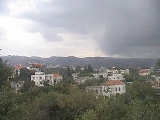
Edde
Encyclopedia
Edde Village is located 45 km North of Beirut
, Lebanon
. It rises to an altitude of 210 meters (689.01 ft - 229 656 yd) of sea level and covers an area of 398 acres (3.98 km ² - 1.53628 mi ²)
Driving direction: Turn right just beyond Byblos
to reach the village of Edde.
The Mar Jurius (Saint George
) Church, which stands in a small square in the middle of the village, was built with Roman temple remains. On a hill further south are the ruins of the church of Sayidat Douka.
Numerous other old churches are scattered around the village, most with ancient temple elements. Amongst these are the double church of Saints John and Theodore, and the churches
of Saint Doumit and Saint Elisha.>
characterized by a hot and virtually rain-free summer, pleasant fall and spring, and cool, rainy winter. August is the hottest month of the year while January and February are the coldest months.
The average annual rainfall is approximately 900 millimetres, virtually all of which falls in winter, autumn and spring. Much of the rain in autumn and spring falls on a limited number of days in heavy downpours. In winter, however, the rain is more evenly spread over a large number of days. Summer receives very little (if any) rainfall. Snow in Edde is rare and usually occurs without accumulation.
Beirut
Beirut is the capital and largest city of Lebanon, with a population ranging from 1 million to more than 2 million . Located on a peninsula at the midpoint of Lebanon's Mediterranean coastline, it serves as the country's largest and main seaport, and also forms the Beirut Metropolitan...
, Lebanon
Lebanon
Lebanon , officially the Republic of LebanonRepublic of Lebanon is the most common term used by Lebanese government agencies. The term Lebanese Republic, a literal translation of the official Arabic and French names that is not used in today's world. Arabic is the most common language spoken among...
. It rises to an altitude of 210 meters (689.01 ft - 229 656 yd) of sea level and covers an area of 398 acres (3.98 km ² - 1.53628 mi ²)
Driving direction: Turn right just beyond Byblos
Byblos
Byblos is the Greek name of the Phoenician city Gebal . It is a Mediterranean city in the Mount Lebanon Governorate of present-day Lebanon under the current Arabic name of Jubayl and was also referred to as Gibelet during the Crusades...
to reach the village of Edde.
Etymology
The name Edde comes from the Semitic root Edd, meaning "Strength".Churches
Saint George
Saint George was, according to tradition, a Roman soldier from Syria Palaestina and a priest in the Guard of Diocletian, who is venerated as a Christian martyr. In hagiography Saint George is one of the most venerated saints in the Catholic , Anglican, Eastern Orthodox, and the Oriental Orthodox...
) Church, which stands in a small square in the middle of the village, was built with Roman temple remains. On a hill further south are the ruins of the church of Sayidat Douka.
Numerous other old churches are scattered around the village, most with ancient temple elements. Amongst these are the double church of Saints John and Theodore, and the churches
of Saint Doumit and Saint Elisha.>
Demographics
Edde is a small Christian Maronite town of approximately 700 residents. In recent Lebanese elections that took place in 2009, the municipality tallying 461 registered voters (226 males and 235 females).Edde Club
| Edde Club is a sports, social and cultural club offering a variety of recreational sports facilities to its members: basketball, soccer, volleyball, table tennis and a gym. It is mostly active during summer season when it hosts national and regional tournaments. |
Climate
Edde has a Mediterranean climateMediterranean climate
A Mediterranean climate is the climate typical of most of the lands in the Mediterranean Basin, and is a particular variety of subtropical climate...
characterized by a hot and virtually rain-free summer, pleasant fall and spring, and cool, rainy winter. August is the hottest month of the year while January and February are the coldest months.
The average annual rainfall is approximately 900 millimetres, virtually all of which falls in winter, autumn and spring. Much of the rain in autumn and spring falls on a limited number of days in heavy downpours. In winter, however, the rain is more evenly spread over a large number of days. Summer receives very little (if any) rainfall. Snow in Edde is rare and usually occurs without accumulation.

